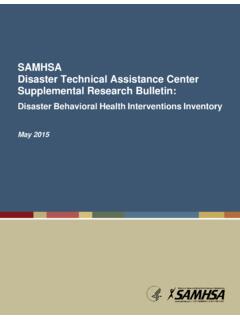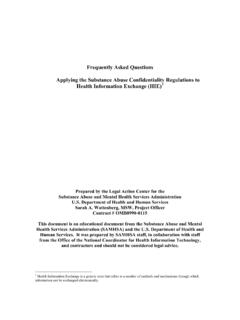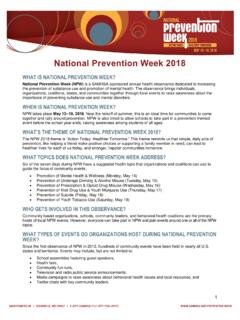Transcription of Key Ingredients for Successful Trauma-Informed Care ...
1 ADVANCING Trauma-Informed care ISSUE BRIEF Key Ingredients for Successful Trauma-Informed care implementation April 2016 | By Christopher Menschner and Alexandra Maul, Center for Health care Strategies IN BRIEF Because of the potentially long-lasting negative impact of trauma on physical and mental health, ways to address patients history of trauma are drawing the attention of health care policymakers and providers across the country. Patients who have experienced trauma can benefit from emerging best practices in Trauma-Informed care . These practices involve both organizational and clinical changes that have the potential to improve patient engagement, health outcomes, and provider and staff wellness, and decrease unnecessary utilization.
2 This brief draws on interviews with national experts on Trauma-Informed care to create a framework for organizational and clinical changes that can be practically implemented across the health care sector to address trauma . It also highlights payment, policy, and educational opportunities to acknowledge trauma s impact. The brief is a product of Advancing Trauma-Informed care , a multi-site demonstration project supported by the Robert Wood Johnson Foundation and led by the Center for Health care Strategies. xposure to abuse, neglect, discrimination, violence, and other adverse experiences increase a person s lifelong potential for serious health problems and engaging in health-risk behaviors, as documented by the landmark Adverse Childhood Experiences (ACE) ,2,3 Because of the ACE study, and other subsequent research, health care policymakers and providers increasingly recognize that exposure to traumatic events, especially as children, heighten patients health risks long afterward.
3 As health care providers grow aware of trauma s impact, they are realizing the value of Trauma-Informed approaches to care . Trauma-Informed care acknowledges the need to understand a patient s life experiences in order to deliver effective care and has the potential to improve patient engagement, treatment adherence, health outcomes, and provider and staff wellness. A set of organizational competencies and core clinical guidelines is emerging to inform effective treatment for patients* with trauma histories (Exhibit 1), but more needs to be done to develop an integrated, comprehensive approach that ranges from screening patients for trauma to measuring quality outcomes. Questions remain for the field regarding how to conceptualize trauma and how to develop payment strategies to support this approach.
4 This issue brief draws insights from experts across the country to outline the key Ingredients necessary for establishing a Trauma-Informed approach to care at the organizational and clinical levels (see Exhibit 1). It explores opportunities for improving care , reducing health care costs for individuals with histories of trauma , and incorporating Trauma-Informed principles throughout the health care setting. * For simplicity, the term patient is used throughout this brief to refer to individuals receiving services in clinical settings. The authors recognize that the terms client and consumer are often used in behavioral health and social services settings.
5 E ISSUE BRIEF: Key Ingredients for Successful Trauma-Informed care implementation 2 Exhibit 1. Key Ingredients for Creating a Trauma-Informed Approach to care Organizational Clinical Leading and communicating about the transformation process Engaging patients in organizational planning Training clinical as well as non-clinical staff members Creating a safe environment Preventing secondary traumatic stress in staff Hiring a Trauma-Informed workforce Involving patients in the treatment process Screening for trauma Training staff in trauma -specific treatment approaches Engaging referral sources and partnering organizations Background Experiencing trauma , especially during childhood.
6 Significantly increases the risk of serious health problems including chronic lung, heart, and liver disease as well as depression, sexually transmitted diseases, tobacco, alcohol, and illicit drug abuse1, 2, 3 throughout life. Childhood trauma is also linked to increases in social service Implementing Trauma-Informed approaches to care may help health care providers engage their patients more effectively, thereby offering the potential to improve outcomes and reduce avoidable costs for both health care and social services. Trauma-Informed approaches to care shift the focus from What s wrong with you? to What happened to you? by: Realizing the widespread impact of trauma and understanding potential paths for recovery; Recognizing the signs and symptoms of trauma in individual clients, families, and staff; Integrating knowledge about trauma into policies, procedures, and practices; and Seeking to actively resist re-traumatization ( , avoid creating an environment that inadvertently reminds patients of their traumatic experiences and causes them to experience emotional and biological stress).
7 6,7 To develop this report, CHCS conducted interviews with nationally recognized experts in the field, including primary care physicians, behavioral health clinicians, academic researchers, program administrators, and Trauma-Informed care trainers, as well as with state and federal policymakers. Information from the interviews is organized within a framework outlining key steps and skill sets essential to Trauma-Informed care . The paper also summarizes opportunities for further exploration to advance the field of Trauma-Informed care . No Universal Definition of trauma Experts tend to create their own definition of trauma based on their clinical experiences. However, the most commonly referenced definition is from the Substance Abuse and Mental Health Services Administration (SAMHSA):4 Individual trauma results from an event, series of events, or set of circumstances that is experienced by an individual as physically or emotionally harmful or life threatening and that has lasting adverse effects on the individual s functioning and mental, physical, social, emotional, or spiritual well-being.
8 Examples of trauma include, but are not limited to: Experiencing or observing physical, sexual, and emotional abuse; Childhood neglect; Having a family member with a mental health or substance use disorder; Experiencing or witnessing violence in the community or while serving in the military; and Poverty and systemic discrimination. ISSUE BRIEF: Key Ingredients for Successful Trauma-Informed care implementation 3 Implementing a Comprehensive Trauma-Informed Approach Trauma-Informed care must involve both organizational and clinical practices that recognize the complex impact trauma has on both patients and providers. Well-intentioned health care providers often train their clinical staff in trauma -specific treatment approaches, but neglect to implement broad changes across their organizations to address trauma .
9 Widespread changes to organizational policy and culture need to be implemented for a health care setting to become truly Trauma-Informed . Organizational practices that recognize the impact of trauma reorient the culture of a health care setting to address the potential for trauma in patients and staff, while Trauma-Informed clinical practices address the impact of trauma on individual patients. Changing both organizational and clinical practices to reflect the following core principles of a Trauma-Informed approach to care is necessary to transform a health care setting: Patient empowerment: Using individuals strengths to empower them in the development of their treatment; Choice: Informing patients regarding treatment options so they can choose the options they prefer; Collaboration: Maximizing collaboration among health care staff, patients, and their families in organizational and treatment planning; Safety: Developing health care settings and activities that ensure patients physical and emotional safety.
10 And Trustworthiness: Creating clear expectations with patients about what proposed treatments entail, who will provide services, and how care will be These attributes form the core principles of a Trauma-Informed organization and may require modifying mission statements, changing human resource policies, amending bylaws, allocating resources, and updating clinical manuals. The following sections describe key strategies for adopting these principles at the organization-wide and clinical levels. Organizational Practices Changing organizational practices to fit Trauma-Informed principles will transform the culture of a health care setting. Experts recommend that organizational reform precede the adoption of Trauma-Informed clinical practices.












